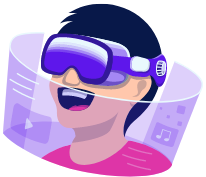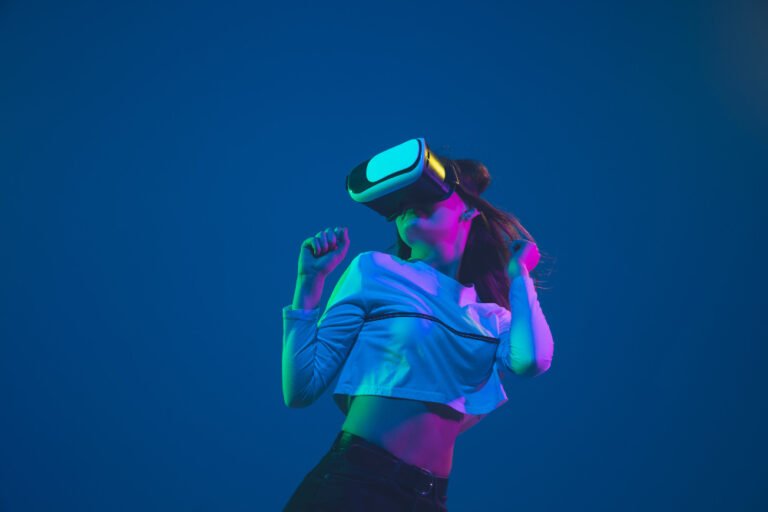Over the past couple of years, The term metaverse emerged in several major news from Novel technology-virtual reality (VR), augmented reality (AR) to blockchain or smart cities. But question is What is the metaverse? The metaverse is a collective virtual shared space, created by the convergence of virtually enhanced physical reality and physically persistent virtual space. It includes all virtual worlds, or augmented realities and the internet. In this article we will investigate the concept of metaverse and its related technologies, centuries evolution till today, so up to date what are already there in terms of tools that can be used for building a world, here is various popular idea behind metaverse along side with possible use cases.
Table of Contents
Understanding the Metaverse
Definition and Origins
To be clear, metaverse is a mashup of “meta-” (as in beyond) and universe. The term was first popularized by author Neal Stephenson in his 1992 science fiction novel “Snow Crash” – a metaverse described as a successor of the internet that is based on virtual reality. In this alternate reality, users functioned as avatars of themselves and other digital agents in a 3D virtual environment.
Core Components
The metaverse is built on several key components:
- Virtual Reality (VR): Virtual reality is an immersive experience which gives users the ability to digitally explore a simulated three-dimensional environment by using hardware such as headset.
- Augmented Reality (AR): AR layers digital content on the real world via devices such as smartphones or AR goggles.
- Blockchain: This technology is vital to the metaverse, which cannot exist without decentralized digital assets and currencies.
- Internet of Things (IoT): Devices that allow connection between digital and physical world in real time.
- Artificial Intelligence (AI): AI makes intelligent avatars, automation and personalization all happen in the metaverse.
Recent Technological Developments

The development of the metaverse has accelerated due to advancements in several technologies:
VR and AR Advancements
This is now changing as we have seen great improvements in VR and AR hardware. High-end, standalone devices like the Oculus Quest 2,Apple Vision pro and Microsoft HoloLens 2 do not need to be tethered to powerful PCs now that makes these products accessible for a vast array of users.
5G Connectivity
5G networks enable the blistering fast, low-latency internet connections needed for VR and AR experiences to be seamless. It allows for more dynamic engagement and better graphics, both necessary elements of immersive metaverse worlds.
Blockchain and NFTs
In the metaverse where Blockchain technology has booted up non-fungible tokens (NFTs), it brought digital ownership into this world. For example, NFTs can grant users the right to own unique digital assets such as virtual real estate and art – not dissimilar to how one might (in theory) actually be able identify which physical paintings are original works from a famous artist. Decentraland and The Sandbox are representing an early move toward developing virtual economies where users can purchase, sell, and trade these assets as part of their world.
AI and Machine Learning
AI & machine learning improve user experiences by offering sophisticated, intelligent and adaptive virtual environments. In contrast, AI-powered avatars mimic a not so smart human being and deliver content or services that are personalized to the extent possible using machine learning algorithms based on your previous interactions.
Popular Metaverse Ideas

Multiple ideas and platforms show the power of metaverse, where some of them are…
Social VR Platforms
We have social VR platforms like VRChat and Rec Room where people can create avatars, meet new friends or play games and attend events together in virtual environments. These platforms prioritize user-generated content and community-based activity, giving us a taste of the social aspects of the metaverse.
Virtual Workspaces
The COVID crisis spurred the use of virtual workspaces. VR platforms empowering virtual collaboration with VR include Spatial and Facebook Horizon Workrooms, which feature in-software rooms for meetings, whiteboarding sessions for collaborative drawing tasks and 3D visualization of models. These instruments are designed to duplicate the physical experience in a digital world.
Virtual Real Estate
Platforms like Decentraland and The Sandbox have popularised the idea of virtual real estate, where users can purchase land, sell it or build on their own 360 square foot plot. These virtual plots became home to digital storefronts, art galleries, concert venues and other applications that created new lines of commerce within the metaverse.
Gaming and Entertainment
The rise of the metaverse is, at its core a result of gaming. Fortnite and Roblox are not video games anymore, they have become places to socially interact, create stuff as well apply together for virtual life work etc. In such games, immersive environments merge entertainment with social interaction through commerce.
Education and Training
The possibilities are immense for the metaverse within education and training. These provide more engaging, interactive experiencesCohorts participate in virtual classrooms and training simulations Using these platforms, lectures are given in VR – as well workshops and project work together with various others types of learning projects.
Potential Impact of the Metaverse
The metaverse has the potential to transform various aspects of life:
Social Interaction
With the development of metaverse, people can connect as if they were together on a face-to-face basis with distant locations in immersive virtual spaces. These could be new types of community and social interactions.
Economy and Commerce
For instance, the metaverse could enable novel business models around virtual real estate and digital assets that feel scarce due to scarcity or interoperable trade via decentralized marketplaces. The lines between physical and digital economies would fade away as more significant economic value is driven by virtual goods and services.
Education and Training
By producing immersive, interactive learning scenarios the metaverse is feasible for instruction and integration of training. It provides students as well as professionals with an opportunity to participate in virtual simulations, work on projects and access resources remotely from any part of this world.
Healthcare
Virtual Consultation, Remote Surgery & Immersive Therapy sessions – The metaverse has vast potential to revolutionise healthcare provision by facilitating medical consultations over a virtual platform. The greater convenience and availability to the patients, as they can access treatment and support without actually leaving their home.
Entertainment and Media
The metaverse will transform entertainment & media, delivering a fusion of gaming, storytelling, social-action in immersive experiences. New entertainment avenues can be opened up with virtual concerts, interactive films and immersive art installations.
Conclusion on What is the Metaverse?
Billions of citizens, around the metaverse will provide diversity to live; physically and digitally into computational worlds. With the further development of VR, AR, blockchain and AI technologies for metaverse creation. The metaverse like horizon world could change the way we live, work and socialize – from gaming to education. This new digital frontier is a brave territory that offers endless opportunities to innovate and connect.
FAQs
1. What is the metaverse?
A metaverse is a collective virtual shared space, created by the convergence of virtually enhanced physical reality and physically persistent virtual spaces, including the sum of all 3D worlds in which humans might be telepresent with each other.
2. How is the metaverse different from the internet?
It is completely based on 3d environment. Combining virtual reality (VR) with augmented reality (AR), along with distributed ledger technology such as that contained in a digital currency like bitcoin enables much more of an integrated framework for the metaverse targeted at enhancing interactivity.
3. What are some popular metaverse platforms?
Decentraland, The Sandbox (SAND), VRChat, Rec Room and Roblox are among the most well-known metaverse projects. These platforms can provide economic, gaming, social interaction and virtual real estate opportunities.
4. How can I participate in the metaverse?
Participate in the metaverse by interacting with virtual worlds and platforms using VR and AR devices. Moreover, you can purchase digital land, establish virtual businesses and join metaverse communities.
5. What is the role of blockchain in the metaverse?
Blockchain technology unlocks the possibility of decentralized digital assets and currencies in metaverse. NFTs Non-fungible tokens (NFT), digital assets in the form of artwork, virtual estate… etc) help users to possess one-of-a-kind pieces and run decentralized markets.

